History
The history of known first settlements in territory of Ordu city dates back to VII. century B.C.
The first settlement known in the city center is Bozukkale (Kotyora) next to the Kirazlimanı Cemetery. On his return voyage from a war in Iran in IV. century B.C. stopped by Kotyora, Greek commander Xenophon, mentioned that they meet a tribe settled there and, after staying there for 45 days, proceeded on their ways. (Anabasis, MEB Y. 1962)
Kotyora was a small colony. Residents of the colony were evacuated in II. century B.C. during times of Pontus Empire Farnak I and relocated to Giresun.
Following around 675 B.C. Middle and East Black Sea, which also contains Ordu, fell under rule of Cimmerians, Miletians, Persians, Alexander the Great and their commanders respectively. Then, the region fell under the rule of Pontus State (280 B.C. - 63 A.D.) for around 3.5 centuries. Roman Empire put an end to this State.
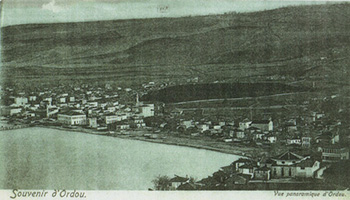 Unlike some historians purporting that Kotyora means Mountain Foot in Greek, Prof. Dr. Necati Demir asserts that the original of the Kotyora word was territory of Kut and Kut Turks lived in there and then this name was transformed. The same scientist says in his studies that the word Bolaman is not a word originated from Pontpolemenyum but from Balaban Turks.
Unlike some historians purporting that Kotyora means Mountain Foot in Greek, Prof. Dr. Necati Demir asserts that the original of the Kotyora word was territory of Kut and Kut Turks lived in there and then this name was transformed. The same scientist says in his studies that the word Bolaman is not a word originated from Pontpolemenyum but from Balaban Turks.
Among the tribes settled in territory of Ordu, Halipians used advanced techniques in mining and processed some minerals, notably of iron, from the lands of Ordu .
According to Xenophon's (born 431 B.C.) Anabasis, non-Greek origin tribes were living during 400 B.C. in Middle and Eastern Black Sea Region (including Ordu), such as Kolhis, Drillians, Mossinoics, Halibians, Tibarens.
There are historical records which show that historical Cıngırt Archeological Site, located in central Fatsa, are used as the recreational area for hetaera of kings of Pont Polemonium.
It is also known that famous Yason Cape in town of Perşembe witnessed human settlements since time immemorial, and one of locations which is mentioned in the world-famous Argonaut myth is situated in here.
The history of historical Kurul Kaya settlement 13km away the city center and today a touristic attraction, goes back to 2.000 years ago.
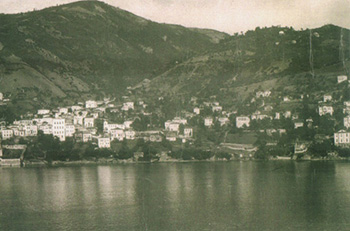 Gölköy Fortress also dates back to older times. This fortress was built by Persian King Dara in V. century B.C.
Gölköy Fortress also dates back to older times. This fortress was built by Persian King Dara in V. century B.C.
Çambaşı Plateau has the traces indicating human settlements since time immemorial. Even today, there are traces that people living in the old ages had dealt with mining.
Castles such as Ulubey Çubuklu, Mesudiye Meletios and Ünye Castle date back to 2500 years ago.
Having many more of such settlements, it is undeniable fact territories of Ordu had been a home to human settlements since time immemorial.
Until arrival of Turks in Ordu (14th century), the region fell under the rule of Roman Empire, followed by Empire of Trebizond.
Settlement of Turks in Ordu
Turks (Çepni brach of Oghuzs) stepped in the lands of Ordu for the first time at Aybastı Perşembe Plateau. There was a pitched battle in the summer of 1105 between 6 thousand army under the command of Emir Danişmend Gazi, Lord of Danişmendoğlu and 70 thousand army of Empire of Trebizond.
Having a heroic fight against overwhelming enemy army, this small Turkish army had to retreat as incurred big losses. Survived but injuried, Danişmend Gazi was taken to Niksar, the capital of Danişmendli Beylic and passed away after some time. His tomb remains in Niksar.
 Tomb of Emir Kümbest, who is thought to be one of his commanders, remains in the cemetery located in this plateau, which also has the graves of martyrs of that battle.
Tomb of Emir Kümbest, who is thought to be one of his commanders, remains in the cemetery located in this plateau, which also has the graves of martyrs of that battle.
Prof. Dr. According to the studies of Prof. Dr. Bahaeddin Yediyıldız, Ordu could be conquered by Turks by the end of 14th century.
"...Hacı Emir Beylic, which was first founded in the region east to Niksar, had advanced towards east by the end of 14th century and Süleyman Bey, who is one the greatest beys of this Turkish beylic, conquered city of Giresun in 1396-97. With this conquest of Süleyman Bey, Oguzh clans such as Çepni, Döğer, Eymir, Karkın, Alan-Yutlu, Bayındır, İğdir settled down in the region. The memories of these clans are still alive in the region. Shortly afterwards, the same Bey conquered the lands of Ordu."
The capital city of said Beylic in the lands of Ordu is Kaleköy, which is today a village of Mesudiye town. Here, there is a castle built by Hacı Emiroğullar and but fell into ruin and a big historical graveyard close to the castle. It is thought that 3 tombs in this graveyard belong to Hacı Emir Beys.
Hacı Emiroğlu Beylic, who inhabited here during 1270s, arrived in Eskipazarı on the Ulubey road 4 km away the center of Ordu only after a very long time such as 130 years.
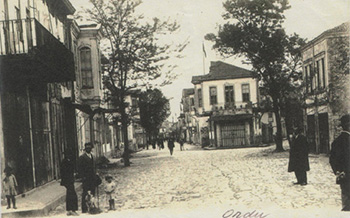 Eskipazar is known to be founded by Hacı Emir Beylic as a small county center.
Eskipazar is known to be founded by Hacı Emir Beylic as a small county center.
Two Turkish baths and one mosque as well as a historical graveyard existing here completely belongs to Turkish.
It is understood by its name, Eskipazar, "Old Bazaar", that a dynamic market was set up in here back in the days.
19. In 19th century, extreme blood feuds occurred between the local landlords. Thereupon, Ottoman Empire assigns Osman Pasha, the commander of troop based in Samsun in order to maintain the order and the safety. After his arrival, commander punished the landlords in the sharpest way and maintained the peace of the community.
However, people living in and around Eskipazar who fed up with the bloody conflicts of this big families, being a sort of overlord, left the region and after a while the town became fully desolated.
What is the origin of the name "Ordu"?
The name "Ordu" had been used in the very first days when Turks arrived in this region. This name is not given, as alleged by few, because Mehmet the Conqueror camped his army in our region in his conquest voyage to Trabzon. Yet, Mehmet The Conqueror arrived in Trabzon through Erzurum.
Again, the hearsay which allegedly bases it to military troop of Osman Pasha coming from Samsun to bring peace is completely false.
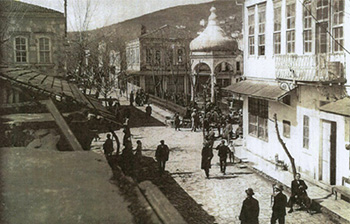 In Yusuf Has Hacib's famous work "Kutadgu Bilig" the word "Ordu" means city, palace, capital city, coastal city.
In Yusuf Has Hacib's famous work "Kutadgu Bilig" the word "Ordu" means city, palace, capital city, coastal city.
In this respect, the old name of Eskipazarı founded by Bayram Bey, son of Hacı Emir Beyi İbrahim, is "Bölük-i Niyabet-i Ordu bi, ism-i Alevi". The word "alevi" was not used in its present day meaning but as a community, a family.
Yet, in Kaşgarlı Mahmud's well-known and great work "Divan-ı Lügat'it-Türk", Ordu means to settle down, the motherland of Khan, to have a capital city".
Ordu county was founded in Eskipazar at the turn of 15th century, with the same name "Ordu" which has still been used today. In official records, Eskipazar settlement is also named as Bayramlı, Bayramlu mea İskefsir ve Milas, Behram Şah, Behramlı, Eyalet-i Behram, Ordu Bayramlu province.
The capital city of the Taceddin oğulları Beylic, which ruled over in the same period with Hacı Emir Beylic, right west to Ordu was also named as Ordu.
Ordu Region in Ottomans Period
The most accurate information about Ordu region which is annexed in Ottoman territories during the reign of Yıldırım Beyazid is found in the official records of Ottoman. (Some historians accept 1427 as the date of annexation). )
There are important information about Ordu in Ottoman Land Title Book of 1455.
Having turned into a Turkish region 65 years before Trabzon, Ordu said to have lower rate of non-Turkish (Rum and Armenian) population than Turkish population.
Even at the turn of 17th century where non-Turkish population is at higher levels, it is just 7.9% of Turkish people.
In the first half of 15th century, there were 6.651 Muslim Turkish house and 526 Non-Turkish house in Ordu territories. These people being Rum and Armenian were Christian. And 326 of them was living in lands of Hapsamana (Gölköy) of Milas (Mesudiye) since Seljuks period.
Even today name of many places and artefacts are Turkish, passed down today. We can give Ulubey town as an example. Ulubey was the title of Sevdeş Bey, which founded and settled in the today's Kardeşler (Sevdeş) Town and made it a town center in 14th century.
No names of the villages is in any other languages except Turkish. Bahaeddin, Durak, Uzunmahmut, Eymür, Şuayp, Sayaca, Kadıncık (Hatuncuk), Ören, Hocaoğlu, Kızılen, Ohtamış and many more. Where you go in city of Ordu, the number of places with non-Turkish names is very few.
From the Land Title records, it is understood that administrative organization of Ordu in Seljuk period mainly remained same.
The region was under administration of Mesne Lords.
In 16th century, it is know that the most important and dynamic center of the region is Gölköy Fortress.
From that times up to end of the 18th century, there was almost no urbanization in the region of Ordu. Eskipazar (Bayramlu) founded by Hacı Emir Beylic has lost its dynamism after a while. Around 1455, Eskipazarı had a group of business owners and craftsmen of 19 houses. Also, there were 47 families which inhabit in their ancient motherlands and do not pay taxes.
Farming was the main source of income for almost entire community. For example, the rate of taxpayer farmer was around 96% in the region by 1520.
Barley, wheat, corn, hemp were mainly farmed.
The number of people who owns a full farmer was 14 in 1613. In the 1485 dated Land Title Book, the name of Ordu region was "Vilayet-i Bayramlu me'a İskefsir ve Milas".
İskefsir, which is today's Reşadiye, a town of Tokat, was a town of Ordu at those days. Milas is today's Mesudiye.
Bulancak, with the name of Kebsil, was a town of Ordu at those days.
Region was divided into 22 administrative units. One of these units was "nahiye", four "niyabet", two "nahiye-i niyabet", eight "bölük", two "bölük-i geriş", two "niyabet-i geriş", one "divan".
In 16th century, Ordu was the capital city of entire Canik.
In 1520, entire region was joined under the name of Kaza-i Canik-i Bayramlu, divided into three sub-districts as İskefsir, Bayramlu (Ordu), Bazarsuyu(Bulancak).
In 1548, Ordu was a part of Karahisar-ı Şarki (Today's Şebinkarahisar town of Giresun) sanjak.
Just as almost every region of Anatolia, Turks are divided into tent, tribe, clan in our region, as well.
Ordu is the region where Çepni Turks, a clan of Oghuzs settled down. Settlements was along the valleys.
Settlements and villages were founded such as Çamaş, Bolaman, Niyabet-i Satılmış (Aybastı) towns and villages along the Bolaman Valley.
Along the Melet Valley, villages and towns were founded, such as Milas (Mesudiye), Alibeğce (Kabadüz) upcountry and Nefs-i Alevi Ordu, Bucak, İhtiyar, Şayiblü, Bedirlü, Ulubey by the seashore.
Establishment of Today's Ordu
Kirazlimanı county was a buoyant settlement before establishment of today's city of Ordu. As per hearsays, the first settlers in this region was sailors. Having visited from time to time, sailors liked the region or for other reasons, established settlements in here.
Hence, Abdullah Reis Masjid, the first masjid of Ordu was built in 1782 in here. However, unfortunately, this artefact which strictly had to be protected was demolished. In that site, Hotel Belde was built and is presently active.
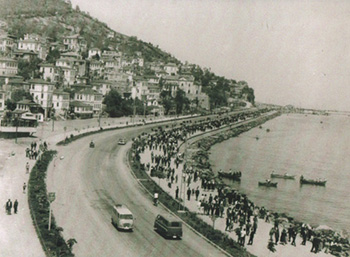 Kirazlimanı is so important that when city of Ordu was completely burned out due to 1883 fire, then experts suggested to make Kirazlimanı as the city center.
Kirazlimanı is so important that when city of Ordu was completely burned out due to 1883 fire, then experts suggested to make Kirazlimanı as the city center.
Yet, Kirazlimanı still retains its importance and beauty.
After Eskipazarı losing its importance, today's Bucak neighbor started to get buoyant and densely populated. (At the turn of 19th century )
Yet, Bucak was a village settlement under the same name for many centuries.
Having became almost a self-sufficient city under the name of Nefs-i Bucak, Bucak has following neighborhoods:
Selimiye, Aziziye, Saray, Kirazlimanı, Taşbaşı and Düz Mahalle.
The name Bucak was replaced in 1869 with the name Ordu which started being used in the official records.
At that times, Ordu was already a small city center.
The first Municipality was established in 1869. According to a letter of lieutenant governor of Trabzon, the first mayor of Bucak (Ordu) was Hasan Aga.
At that times, Ordu had three towns. These are Perşembe, Aybastı and Ulubey me'a Hapsamana Hapsama is present Gölköy. However, after a while, Ulubey and Gölköy are separated to individual towns.
1872'de Ordu kazasındaki binalar şöyle tespit edilmiştir:
Government building, Customs building, Quarantine building, Telegraph Office, 15 fountains, 2 Water-tanks, 1 madrasa, 5 Islam madrasa, 1 secondary school, 3 mosques, 28 lodging rooms, 1 Turkish bath, 17 bakeries, 158 stores, 273 shops, 1 bastion, 1 lighthouse and 854 houses.
In 1872, Motherland Fund, the first name of Ziraat Bank, is established in Ordu.
From City to Province
In 1920, city of Ordu had 6 towns, 318 villages and a population of 180 thousand. In other words, it was the most developed city center of Trabzon Province.
There was a great effort in Grand National Assembly Of Turkey to make Ordu a province. There important person who made great efforts were Mesudiye Deputy Serdaroğlu Mustafa Bey, Tunalı Hilmi and Şebinkarahisar Deputy Memduh Bey. Some deputies (one of them was famous religious scholar Konya Deputy Vehbi Bey) also made great efforts to make Ordu a part of Giresun. After long and tiresome sessions, with the decision of grand national assembly of turkey, Ordu was made a province on April 4, 1920.
Big Ordu Fire
In 1883, during the time of Mayor Katırcıoğlu Mustafa Aga, a big fire broke out in Ordu. It was July. Because of summer, bakeries were making kadayıf, a Turkish pastry. A Pavli-named Rum was making kadayıf, too. A night of July, while Pavli was again making kadayıf, flames suddenly set bakery roof on fire. Then, fire spread to other buildings. Fire broken out in the night could not be extinguished. Because, Municipality did not have a fire station. On top of that, most of the buildings were wooden and shingle roofed. Unfortunate fire started at that night continued next day until noon and all of the wooden buildings were burned to the ash.
Only Orta and Yalı Mosques survived. Because fire was not spread to them thanks to the clearance around them. In addition, many buildings around the Fountain were owned by Rum and Armenians and masonry. Therefore, they were partially damaged from the fire. Being masonry, Osmanpaşa Fountain also survived the fire. Central Bazaar was burned down to the ashes. City of Ordu virtually disappeared.
It was necessary to rebuild the city. For this, Mayor Mustafa Aga was confronted with major difficulties. The next Mayor, Felekzade Süleyman Aga made great efforts to rebuilt the city despite of all pressures. He fought relentlessly with those who opposed the widening of streets.
The present city plan of Ordu is a work of Süleyman Aga.
On this occasion, it should be noted that;
If Ordu did not undergo that fire and buildings of that time, however wooden, was protected, today's Ordu would remain authentic and had a great tourism opportunities.
Following 1875s, malaria had become a nightmare for all Ordu residents. Many people was dying because of that disease. Thereupon, City officials and rich people were living in Çambaşı Plateau during summer, and returning the city center in September-October.
A town hall was built in the Plateau. And this building disappeared due to fire.
Another important event was this: Poet Sir Tıflı published a hand-written newspaper with the name of Interior News. While it remains unknown how long it took, even a single issue of it did not pass down today.
Çambaşı Plateau is a unique in terms of having the first and sole newspaper and being a city center among Plateaus.
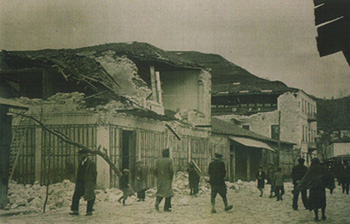 Erzincan Earthquake of 1939 demolished Ordu extensively for the second time. Many important artefact in the city center was demolished and disappeared.
Erzincan Earthquake of 1939 demolished Ordu extensively for the second time. Many important artefact in the city center was demolished and disappeared.
Bibliography:
- * Ordu Yöresinin Tarihi Kaynakları (Prof. Bahaeddin Yediyıldız - Ünal Üstün)
- * Ordu Şehri Belediye Tarihi (Sıtkı Çebi)
- * Danişmendname (Prof. Dr. Necati Demir)
- * Ordu Şehri Hakkında Derlemeler ve Hatıralar (S. Çebi)
- * Atatürk Ordu'da (S. Çebi)
- * Ordu Tarihinden İzler (Prof. Dr. B. Yediyıldız)
- * OOrdu Kazasının Sosyal Tarihi (Prof. Dr. B. Yediyıldız)
- * Ordu Yöresinde Oğuz Boyları (Mithat BAŞ-Ahmet Gürsoy)
- * Ordu Basın Tarihi (S. Çebi)
- * Ordu Kültür ve Turizm Envanteri (Ordu İl Kültür ve Turizm Müdürlüğü Yayını)

